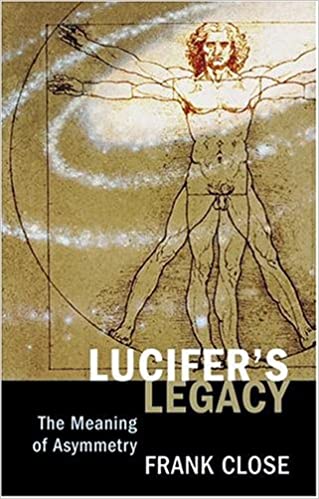by Frank Close, Oxford University Press, ISBN 0 19 850380 6.
Communicating science is difficult. In contrast with other fields, it needs long experience before being able to contribute. While creativity in science or the arts is often left to younger people with open minds, when it comes to explaining new developments to a wide audience, the science communicator first has to master the science itself, its teaching and its popular dissemination.
Frank Close, who has already provided several popular science standards, has all it requires. Here he takes us on a tour of modern science, following a theme, the study of which started early in 19th century: the fascination and appeal of the underlying symmetry of nature, and its attendant asymmetry.
The tour begins and ends in Paris, in a French garden where almost perfect symmetry appears slightly broken, that day, by a damaged statue of Lucifer. With this metaphor of our entire world, accidentally asymmetric but governed by apparently symmetric laws, Close embarks on a journey through the history of the quest to understand where the asymmetry of the universe comes from.
This governs even our own existence: matter overcoming antimatter was a necessary step for there to be anything at all. Moreover, life on Earth, seen through the basic structure of organic molecules, is asymmetric. The mystery of life cannot be understood by physics alone, yet asymmetry is a property of life itself, and this thread continues throughout the book.
First the author reviews symmetry at large, with examples taken from everyday life, featuring common notions and clichés. One of the enigmas dealt with is my own favourite, Martin Gardner’s puzzle: why does a mirror invert left and right, but not top and bottom? Here the author adds much of his own insight and wit (“the muscles which close a mouth are stronger than those which open it – as is well known to all who have sat in committees”). The result is a fascinating panorama, down to the molecular level, of the asymmetries around us, which have first to be discovered before being explained.
The remainder of the book covers the history of the tools needed to explore matter and to reveal its hidden asymmetries. Following the pioneer work of Biot (polarization of light) and Pasteur (study of racemic acid), the end of the 19th century brought major discoveries by scientists investigating the true nature of electricity, continuing the route taken by Faraday and Maxwell.
First came the discovery of X-rays by Roentgen, a key tool for decoding DNA structure half a century later. Immediately after X rays came the discovery of the electron by Thomson, and then of radioactivity (Becquerel and the Curies) and the nucleus (Rutherford). The major cornerstones of modern physics were revealed during those few “magic” years, and they are narrated by Close in a way that reveals the hesitations and inspirations of the actors, the banal errors of those who “could have found” (Lenard, Crookes) but were not quite ready, and the genius of those who made sure that they were in the right place at the right time with the right ideas. What better plea could there be for fundamental research?
All of this leads to modern physics, exploiting the concept of symmetry in a profound way, revealing hitherto unsuspected laws through delicate symmetry breaking. We are introduced to unification schemes based on symmetries broken at our energy scale, but revealed in high-energy experiments. Close explains this in detail and with amusing anecdotes, and how it guided physicists during their major discoveries of the secrets of the matter, right up to the next foreseen step – the quest to find the Higgs boson.
The instrumentation and apparatus required for this quest are impressive. The incredible effort of a worldwide community at CERN for the LHC and its giant experiments help the reader to become familiar with this ultimate search for the origin of mass.
On the way, the chapter on antimatter deserves admiration: antimatter is one of the most difficult notions scientists have to explain. I remember a colleague beginning a public talk by unapologetically defining antimatter as “the negative energy solution to Dirac’s equations”. What is exact is not always clear, and Frank Close takes the time to introduce antimatter, to draw its human side through Dirac’s character and by noting the time it took, from Dirac’s work in 1928 to Anderson’s discovery of the positron in 1932.
The violation of “mirror” P symmetry by the weak force, how this was discovered, the violation of CP symmetry and recent evidence for the violation of time symmetry are all clearly explained, illustrated by analogies with Escher prints to help the mind see patterns in abstract spaces.
We then understand that the universe, once fully symmetric, exhibited asymmetries when freezing, which enabled life to be. Life, intrinsically related to asymmetries, is the theme of this book, and Close revisits what has already been written on this theme, offering us an absorbing and scientifically correct account of symmetry and its deep implications.






